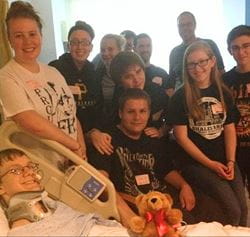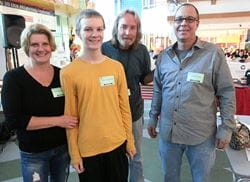On Memorial Day weekend 2014, 16-year-old John Richardson was involved in a car crash in the early hours of the morning. John was a passenger in a car going 95 miles per hour down the winding Saxonburg Boulevard when the driver missed a turn and hit a pole, sending the car across a creek and ultimately into a retaining wall. The crash resulted in John being in critical condition and the others in the car being hurt badly as well.
 Police and EMTs responded quickly and took John to UPMC Children’s Hospital of Pittsburgh via ambulance. Once in the Emergency Department (ED) around 4:15 a.m., doctors continued treating John and ran various tests to determine the extent of his injuries.
Police and EMTs responded quickly and took John to UPMC Children’s Hospital of Pittsburgh via ambulance. Once in the Emergency Department (ED) around 4:15 a.m., doctors continued treating John and ran various tests to determine the extent of his injuries.
When John arrived, lacking an ID, hospital staff initially couldn't contact his parents because they were unsure of his identity. While doctors were attending to him, a social worker at the hospital was eventually able to figure out who he was and was able to locate his father’s number. By 7 a.m., John’s parents Mandy and John Sr. were there beside him.
Doctors determined that John sustained a seat belt injury – sometimes referred to as seatbelt syndrome. Seatbelt syndrome is a specific pattern of injuries, typically to the upper torso, chest, and abdomen, caused by the restraining forces of a seat belt during a car accident.
John’s abdomen was segmented by his seat belt. It lacerated his stomach, liver, intestines, and pancreas. His L2 vertebrae was compressed, and he was having trouble moving his legs. In addition, one of the most severe injuries he sustained was a torn aorta.
 John’s parents said goodbye to him before he went in for a nine-hour surgery with a team of Children’s surgeons including neurosurgeon Stephanie Greene, MD. During the surgery, doctors meticulously repaired all the affected organs and inserted a lifesaving stent, wrapping it around the outside of his aorta to hold it together.
John’s parents said goodbye to him before he went in for a nine-hour surgery with a team of Children’s surgeons including neurosurgeon Stephanie Greene, MD. During the surgery, doctors meticulously repaired all the affected organs and inserted a lifesaving stent, wrapping it around the outside of his aorta to hold it together.
After surgery, he was moved to the Pediatric Intensive Care Unit (PICU) where he would stay and recover. He couldn’t eat or drink anything for seven days because of his stomach repair.
“From the day I met John in the ED, I didn’t leave the hospital the whole time,” said John’s mother Mandy. “Everyone at Children’s took just as good care of me as they did him. They patiently answered all our questions. They even offered me a gift bag with snacks and shampoo and things – it was a small thing that made a big difference.”
According to Mandy, once John was moved to the PICU and began to heal, he made progress quickly.
“One day they were telling us about nursing homes and assisted places and then a day or two later, he was able to sit up. He just kept getting better, it was amazing,” she said.
After a few days, John began to slowly incorporate physical therapy. It was, of course, very difficult after undergoing such an extreme surgery. However, when one of Children’s therapy dogs – a fluffy golden retriever – walked by John’s room, it brought with it the motivation he needed. John was immediately intrigued and stood up with his walker and walked all the way up and down the hallway. Mandy says that from that day on “he was moving.”
“We say that golden retriever saved his life. He was having a hard time and even starting to get pneumonia from not moving. Once he got moving, it really got everything working again.”
After spending just nine days in the hospital, John could go home.
John never ended up having to have surgery on his back to repair his vertebrae.
“He was so young that it was able to fuse together on its own,” said Mandy.
 He sustained a concussion in the accident and had to work through that as well. Once home, he had to continue physical therapy. The goal of it all was to help John get through “normal everyday things,” said Mandy.
He sustained a concussion in the accident and had to work through that as well. Once home, he had to continue physical therapy. The goal of it all was to help John get through “normal everyday things,” said Mandy.
“At the beginning, he would get stuck in bed because he had no ab muscles. He was very active before the accident, so getting back into different activities was a big part of his recovery.”
For the first six months, the Richardson’s had many follow up appointments to monitor John’s healing. John met with many specialists from neurosurgeons to monitor his concussion and his spine to nutritionists to help him regain all the weight he had lost. John also played a lot of basketball during his recovery.
“His friends all knew not to knock into him. Basketball did a lot for his mental health too. The mental aspect was so important and had a lot to do with his overall recovery,” said Mandy.
John is now 25 years old and working as a cook in Pittsburgh. He is healthy and back to normal.
He has only had one additional surgery over the years at an adult hospital to have his stent upgraded from a pediatric stent to an adult-sized one.
 Mandy says she’s thankful for the supportive friends and community that formed around John and the family during that time.
Mandy says she’s thankful for the supportive friends and community that formed around John and the family during that time.
“Many of those friends are still around. It was amazing how the community pulled together when it was bad,” she said.
“We’re so thankful for the paramedics that responded that day and got John to the hospital fast. And we’re of course so thankful to all of John’s doctors and surgeons and all of the staff at Children’s.”
Mandy also talked of the importance of UPMC Children’s Hospital Foundation’s Free Care Fund – a fund that exists so that every child at Children’s can receive the care they need, regardless of their family’s ability to pay.
“It’s very reassuring to know that if insurance didn’t pay, there was a backup plan. Just knowing that helped me be stronger. When he first got there, they didn’t even know who he was let alone what insurance he had, but they continued to treat him without pause,” said Mandy. “I really can’t thank them enough for saving my son’s life. I am forever grateful to be a Pittsburgher and be so close to such an amazing hospital.”









